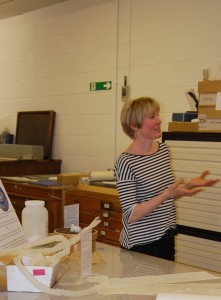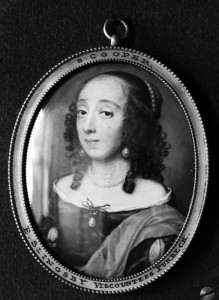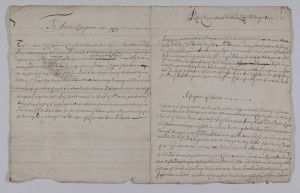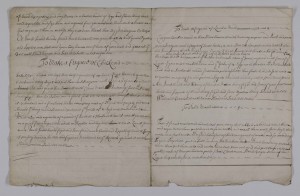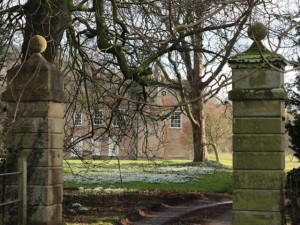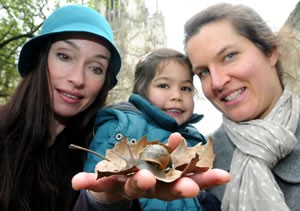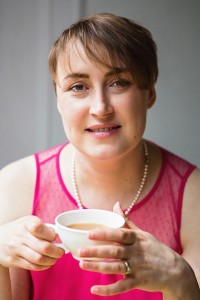What could delight a blog writer more than to learn that an article sent out with a press of the ‘publish’ button, and left to wander where it will through the ether of our virtual world, has found fresh favor with a new reader?
A few days ago I received a message from Rachel Greenwood in England. Rachel is Conservation and Digital Manager at the North Yorkshire Record Office in Northallerton.
Rachel wrote: “What a great find, your blog on Elizabeth Slingsby. North Yorkshire County Record Office have recently acquired the Norton Conyers archive. Myself and Claire Davies a food historian are recreating one of her recipes at the York Food Festival in two weeks, so great to learn so much more about her and to see her portrait!”
I felt instantly elated that my blog about Elizabeth could still be useful and enjoyable for others. Here again is the portrait:
Unexpectedly, and thanks in large part to Rachel, I’ve been revising my relationship with this 17th century woman upon whom I had hitherto cast a sour eye! Those of you who read my initial blog https://www.nightsoftheroad.com/?p=501 may remember that I struggled, unsuccessfully, to feel any ‘milk of human kindness’ toward the woman who married John Villiers in 1646, to become the second Viscountess Purbeck.
I confessed to experiencing an antipathy toward Elizabeth Slingsby, from the moment of first gazing upon her face, in that beautifully-executed miniature by Samuel Cooper. I did acknowledge that my reaction might be due to partisanship. After travelling for so long in company with Frances Coke’s story, and having felt touched by John Villiers’ loyalty toward his young wife, in the face of an unkind world and her love for another, I felt unexpectedly betrayed. In my eyes, John had simply no business to have married again so soon after the first wife he adored left life’s stage. And it didn’t help that something about Elizabeth Slingsby’s ‘limpid’ gaze irked me!
I’d like to be able to tell you that I felt an immediate softening toward the second Viscountess after reading Rachel’s message but, when I first revisited the February blog, I experienced no such stirring of empathy. My attitude toward Elizabeth continued to feel distinctly chilly, until Rachel sent me a copy of the recipe that she and Claire Davies will be recreating at the York Food Festival next week:
My attention was caught. As I began to decipher Elizabeth Slingsby’s neat handwriting and her detailed instructions for the ‘Frigacie of Rabots’, which I have permission to share with you here, I began to be fascinated by the type and variety of ingredients available to those living at Norton Conyers in the period, as well as by the time-consuming steps involved in serving up so relatively simple a dish as rabbit fricassee.
I worked my way further through her text and learned that Viscountess Purbeck and her northern family also had a taste for fricasseed chicken, stewed carp and pickled mushrooms…
And then it suddenly happened! Elizabeth came to life before me and, for the first time, I recognised her as a fellow human being. I had an image of a woman of flesh and blood, standing in a kitchen at Norton Conyers House in the second half of the 17th century, engaged in making a dish for her loved ones and/or some visitors. There she stood, laboring long and lovingly in preparation of a meal, in much the same way that I could be working today to cook and serve a blog dish for regular readers and occasional visitors like Rachel, here at nightsoftheroad.com.
In my mind’s eye, I saw no sign of the ‘neclace containing fourscore and fourteen pearls’ that Elizabeth Slingsby bequeathed to her daughter, nor even of the single large pearl which had adorned her dress in Cooper’s miniature. Instead, in my vision, the second Lady Purbeck was dressed in an embroidered and slightly faded but entirely serviceable linen apron that reached to the floor. The sleeves of her tight-fitted bodice were firmly rolled up. Her face was pink and showed signs of exertion, as small hands wrestled to slit in half 16 sheep’s tongues scattered on the table in front of her. Wisps of recalcitrant ringlets threatened to escape from a close-fitting coif, as the widow bent over her ingredients, in single-minded concentration.
Of course, this entire scene may exist only in my imagination. For all I currently know, Elizabeth Slingsby may actually have lived a life of leisured ease and never ventured further into that Norton Conyers kitchen than to issue curt orders to a harassed cook and over-worked scullery maid. The closest she may have come to rabbits and ‘breaking their bones with a Cleaver ‘ may have been to write out the recipe and enjoy the result, when it appeared on her dinner plate, cooked and served up through the labors of others. But she at least made the all-important effort to record that recipe and much else besides, both for the benefit of those living at and visiting Norton Conyers in her lifetime and now for any in posterity who may be interested to learn about the century in which she lived.
With luck, we will all soon know much more about Lady Purbeck II’s life in North Yorkshire, when the Norton Conyers archive has been studied, recorded and shared, through the efforts of Maxine Willett, project archivist, and her team of volunteers at the County Record Office.
Meanwhile, as I gaze upon the well-formed script in those two precious pages from Elizabeth’s notebook, I feel a new sense of connection with her. Cooking and sharing recipes, as those who are organizing the York Food Festival obviously already know, can bring people together, even across the centuries and the miles!
And for that I feel grateful, since to hold mean-spirited feelings toward a woman who lived nearly four hundred years ago seems both disrespectful to the ancestors and small-minded in our current era, when learning to get along with each other seems an ever-more-urgent priority.
I would love now to spirit myself across the ocean, and be present at 11 a.m. on 23rd September in the Demonstration Tent at Parliament Street, York, when BBC Radio York will play host to Claire Davis and Rachel Greenwood. I bet that ‘Frigacie of Rabots’ will smell and taste good. And I wonder if, across the centuries, Elizabeth Slingsby’s nostrils may twitch in appreciation that she is being thus remembered and honored?
If you happen to be within striking distance of the beautiful city of York yourself next Wednesday, you may want to get tickets for their demonstration. For full details of the whole festival (and to see some Yorkshire snails!)go to http://www.yorkfoodfestival.com/media.php
If such a trip is not feasible, you can still pay a visit to food historian Claire Davis’s interesting blog at http://greedywordsmith.com/about/ While there, you can leaf through some recipes from the York Food & Drink 2015 Festival Book. Claire sounds like a person with a remarkable history, and well worth getting to know in her own right. I enjoyed learning more about her also at http://historygirlsyork.com/about
Now I’m looking forward to the possibility of deepening my acquaintance and knowledge, over time and across the miles, with Rachel Greenwood and Maxine Willett at Northallerton. The Norton Conyers archive is likely to reveal invaluable insights for those of us who eager to better understand and portray 17th-century daily feminine life accurately for our readers. In particular, Rachel says: “Elizabeth’s note book which contains, recipes, remedies, daily household accounts and religious sermons is very enlightening on the role of an elite woman of the time responsible for the physical and moral wellbeing of the family.”
So I’m excited to learn more about this 17th-century woman toward whom I now feel kindly disposed, thanks to a recipe and a 21st century conservator, who first found her serendipitous way to my blog and then was good enough to reach out and tell me of her visit.
By the way, the North Yorkshire Record Office has some fascinating publications, a website that is a model of easy access and a lovely online shop, that many a county record office might do well to emulate. Why not take a trip there too?! http://archiveshop.northyorks.gov.uk
Thank you Rachel! And thank you:
for taking such pains to conserve our heritage.

